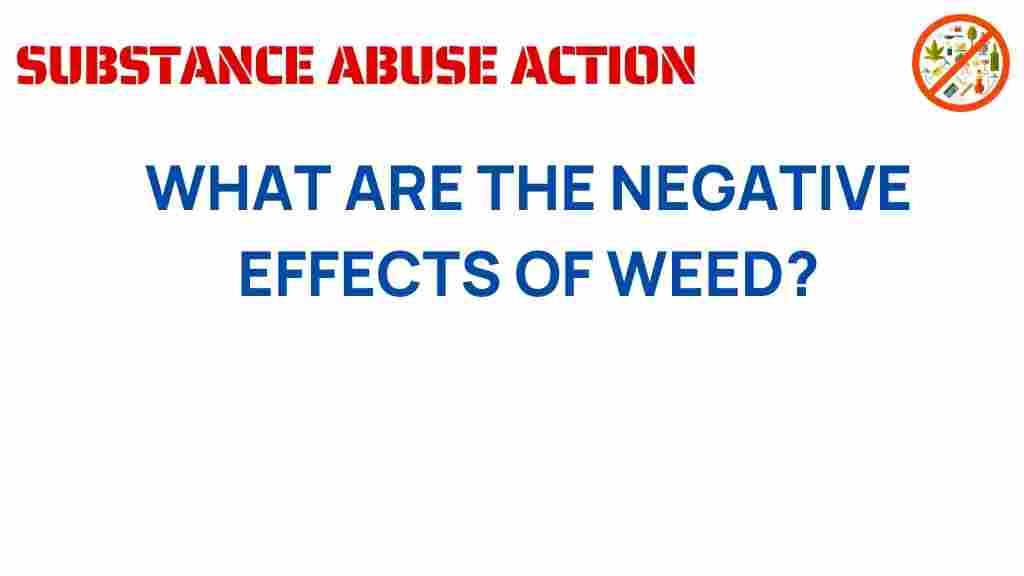Unveiling the Hidden Dangers: What Are the Negative Effects of Weed?
As cannabis, commonly known as weed, continues to gain popularity and acceptance across various regions, it is crucial to examine the negative effects associated with its use. While many people advocate for the benefits of cannabis, such as pain relief and relaxation, there are significant health risks, addiction potential, and mental health concerns that deserve attention. In this article, we will explore the hidden dangers of weed, aiming to raise awareness and inform public perception regarding its use.
Understanding Cannabis and Its Components
Cannabis is a complex plant containing various compounds known as cannabinoids. The two most notable cannabinoids are:
- THC (tetrahydrocannabinol): The primary psychoactive component that induces the “high” associated with marijuana use.
- CBD (cannabidiol): A non-psychoactive component often touted for its potential therapeutic effects.
While CBD is often marketed as a safer option, it is essential to recognize that both THC and CBD can have negative effects on health if misused or overused.
The Negative Effects of Weed on Health
When discussing the negative effects of weed, it is vital to consider both physical and mental health risks. Here are some of the most significant concerns:
1. Respiratory Issues
Smoking weed, similar to smoking tobacco, can lead to respiratory problems. Regular use may result in:
- Chronic cough
- Bronchitis
- Decreased lung function
These respiratory issues stem from inhaling smoke, which contains harmful chemicals that can irritate the lungs.
2. Impaired Cognitive Function
Cannabis use has been linked to impaired cognitive abilities, particularly in young users. Studies show that regular use can lead to:
- Memory problems
- Difficulty concentrating
- Reduced problem-solving skills
These cognitive deficits can have long-term effects, especially when use begins in adolescence.
3. Mental Health Risks
There is a growing body of evidence suggesting a connection between cannabis use and mental health disorders. Potential risks include:
- Anxiety disorders
- Depression
- Psychosis, particularly in individuals predisposed to schizophrenia
Understanding these risks is crucial for users to make informed decisions about their health.
4. Addiction Potential
Despite the perception that cannabis is less addictive than other substances, research shows that approximately 9% of users develop a dependency on weed. This number increases to:
- 17% for those who start using in their teens
- 25-50% among daily users
Withdrawal symptoms can include irritability, insomnia, and loss of appetite, making it challenging for some individuals to quit.
Impact on Public Perception
As cannabis becomes more mainstream, public perception is shifting. Many view cannabis as a harmless substance, often overlooking the negative effects. This change in perception can lead to increased use, particularly among younger populations who may underestimate the associated risks.
Awareness campaigns are crucial in educating the public about the potential dangers of cannabis use. It is vital for individuals, especially parents and educators, to engage in open dialogues about the risks of cannabis and its effects on health.
Step-by-Step Process to Mitigate Risks
For those who choose to use cannabis, understanding how to minimize the negative effects is essential. Here is a step-by-step process to mitigate risks:
Step 1: Educate Yourself
Before using cannabis, educate yourself about its effects. Understand the difference between THC and CBD, and know the potential health risks associated with each.
Step 2: Choose Consumption Methods Wisely
Consider alternative methods of consumption that may have fewer health risks, such as:
- Edibles
- Vaporization
- Tinctures
Step 3: Start with Low Doses
If you decide to use cannabis, start with low doses to gauge your body’s reaction. This approach can help prevent overwhelming effects and reduce the likelihood of negative experiences.
Step 4: Monitor Your Usage
Keep track of how often and how much you are using cannabis. Being mindful of your consumption can help you avoid developing a dependency.
Step 5: Seek Help if Needed
If you find that cannabis use is negatively impacting your life, don’t hesitate to seek help. Various resources are available, including counseling and support groups.
Troubleshooting Tips for Cannabis Users
Sometimes, users may encounter unwanted side effects from cannabis. Here are some troubleshooting tips:
1. Anxiety or Paranoia
If you experience anxiety or paranoia after using cannabis, try the following:
- Engage in deep breathing exercises to calm your mind.
- Find a quiet space to relax until the effects subside.
- Consider using CBD, which may counteract some of the anxiety-inducing effects of THC.
2. Impaired Coordination
If you feel uncoordinated or dizzy:
- Avoid driving or operating heavy machinery.
- Stay in a safe environment until the effects wear off.
3. Increased Heart Rate
If you notice an increased heart rate:
- Focus on calming activities, such as listening to soothing music.
- Stay hydrated to help your body process the substance.
Conclusion
As cannabis continues to be embraced by society, it is imperative to remain aware of the negative effects associated with its use. From health risks to addiction and mental health concerns, understanding the potential dangers of weed can empower individuals to make informed choices. Awareness is essential in shaping public perception and ensuring that the conversation around cannabis is balanced and truthful.
For more information on substance use and its effects, consider visiting the National Institute on Drug Abuse (NIDA) for comprehensive resources.
By fostering open discussions and providing educational resources, we can help mitigate the negative effects of cannabis and promote a healthier society.
For those seeking to learn more about safe cannabis consumption practices, check out our detailed guide on cannabis use and health.
This article is in the category Health and created by SubstanceAbuseAction Team
